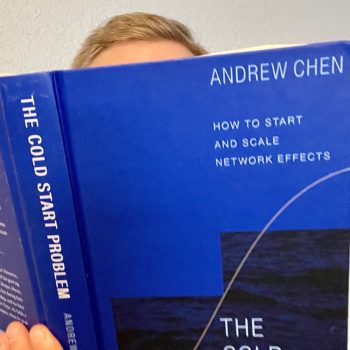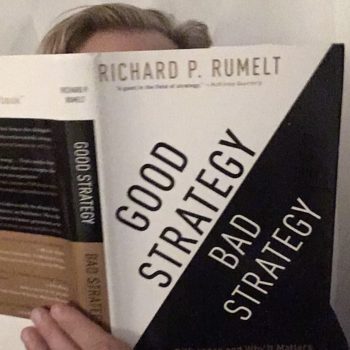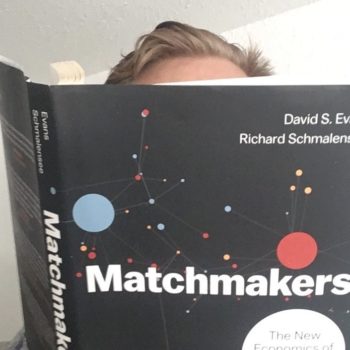How strongly do I recommend The Cold Start Problem?
9 / 10
Review of The Cold Start Problem
Have you ever wondered how companies like Uber and Airbnb captured their market, built a robust network of buyers and sellers, and created a defensible moat around their business? The Cold Start Problem by Andrew Chen outlines the path that networked product companies like Tinder, Instagram, Dropbox, Airbnb, Reddit, and Uber used to drive growth.
The product strategies and tactics in this book feel surprisingly tangible. Chen presents a multitude of examples from the early days at these companies to explain how network effects can be created and leveraged for growth.
Top Ideas in This Book
- There are five stages of network effects: Cold Start, Tipping Point, Escape Velocity, Ceiling, Moat
- Network effects are not all positive, they consist of both virtuous and vicious cycles
- Atomic networks create a repeatable pattern for network expansion
- Your first atomic network should be small and highly specific
- Expect users to engage through the 1/10/100 rule
- Supply is usually the hard side of the network to fill
- Come for the tool, stay for the network
- Three types of network effects: Acquisition, Engagement, Economic
- Most marketplaces are built on underutilized assets
- Bundling products only works when the products are superior
There are five stages of network effects: Cold Start, Tipping Point, Escape Velocity, Ceiling, Moat
Andrew Chen describes five stages of network effects, which he calls The Cold Start Theory:
- Cold Start – You start with nothing and network effects are actually hurting you at this point. Users arrive at your site or app and it’s a ghost town. Solving the cold start problem requires getting the right users and content on the network simultaneously. This is very hard and most products never achieve it.
- Tipping Point – By now you have at least one atomic network functioning but that’s not enough. You need to replicate your success in new networks. Uber didn’t want to just own San Francisco, they wanted more cities. Reaching the tipping point is about expanding into new networks at an increasing rate.
- Escape Velocity – Now you need to scale. The tipping point has passed and you’re trying to maintain momentum. Network effects start to kick in. Users are acquired more virally, lowering your customer acquisition cost. Users demonstrate high engagement as the app becomes more valuable with more users. Your unit economics start to improve as you understand how to monetize users better.
- Hitting the Ceiling – Growth plateaus. Paid marketing no longer has the same effect due to the Law of Shitty Clickthroughs. You fight trolls and fraudsters to maintain quality, but it’s a struggle. When you break through one ceiling you encounter another.
- Moat – You aren’t the only company leveraging network effects to this product space, your competitors are doing the same. If done well, you have the largest and most committed network which creates a defensible moat around your business.
Network effects are not all positive, they consist of both virtuous and vicious cycles
Network effects work for you when your network is growing and healthy. But when your network is non-existent, network effects work against you. Users come to your app and it feels empty.
How many users does your network require before it becomes a good experience? With a product like Zoom that might be two users – just enough to have a video chat. But with a product like Uber, it doesn’t do much good to have just one rider and one driver in a city, you need many riders and many drivers.
Atomic networks create a repeatable pattern for network expansion
During Cold Start and Tipping Point, you are building atomic networks, which are the smallest network that can stand on its own. Tinder in a single city, for example.
Once you find a pattern that works for creating atomic networks, your job is to rinse and repeat. Do things that don’t scale in order to get each atomic network running. Eventually you will connect your atomic networks into a larger network with even stronger network effects.
Your first atomic network should be small and highly specific
Most atomic networks are smaller and more specific than you imagine. Harvard University students for Facebook. Rush hour at Port Authority in New York for Uber.
Attacking these small and underserved pools of customers is a good way to stay under your competitor’s radar. To competitors and incumbents, these tiny networks look unattractive. They don’t drive significant revenue so your competitors ignore them. But you are in the business of building small and dense atomic networks, one by one.
Expect users to engage through the 1/10/100 rule
For every 100 users on your platform, 10 will engage through more passive means such as commenting and liking. One user out of 100 will actually create content. In other words, most of the people on your platform will be lurkers.
Supply is usually the hard side of the network to fill
Networks have an easy side to fill and a hard side to fill. Usually supply is the hard side. Take Uber, where drivers are the hard side of the network.
To build your supply side, you often need to subsidize their work. Uber guaranteed drivers a minimum hourly rate, created goals with monetary rewards, and instituted driver referral bonuses to get the supply side filled. As the supply side filled out, Uber could pull back on the subsidies.
Professionalizing your creator experience is another way that companies grow their supply side. For instance, Instagram created filters and made them easy to use. Over time, Instagram added more creator tools and professionalized their product for suppliers with features like subscriptions.
Come for the tool, stay for the network
Having a strong SaaS offering will help support your network. Users will join for access to the SaaS tool, operating in single player mode. As they become familiar with the tool, they look for ways to distribute the content they are producing and that’s where your community features come in.
Tools often drive acquisition and networks drive retention. This is important for product managers to understand because it’s tempting to enter into a feature rat-race with your competitors. But features are easy to copy, it just requires time and money. Networks are much harder than features to copy.
Three types of network effects: Acquisition, Engagement, Economic
Whereas most people talk about network effects as a singular concept – when a product becomes stronger the more people that use it – Andrew Chen breaks down network effects into three varieties:
- Acquisition network effects – how products leverage existing users to acquire new users
- Engagement network effects – how denser networks create higher stickiness; this is what people traditionally think of as network effects
- Economic network effects – how a networked product leverages economies of scale, accelerates monetization, and generally improves operations as the network grows
I found this distinction useful for talking with product managers about network effects because it encouraged us to get more specific about what we mean.
Most marketplaces are built on underutilized assets
Uber leverages underutilized driver time and underutilized cars. Etsy leverages producers’ free time. Airbnb leverages unused bedrooms and housing.
Building a marketplace is tough, but if you can help people leverage an underutilized asset then you might stand a chance.
Bundling products only works when the products are superior
Bundling products is not a panacea. Your combined offering is not instantly better than those products standing on their own and that’s because the products themselves still need to be superior products. You can’t bundle inferior products and hope to be successful.


